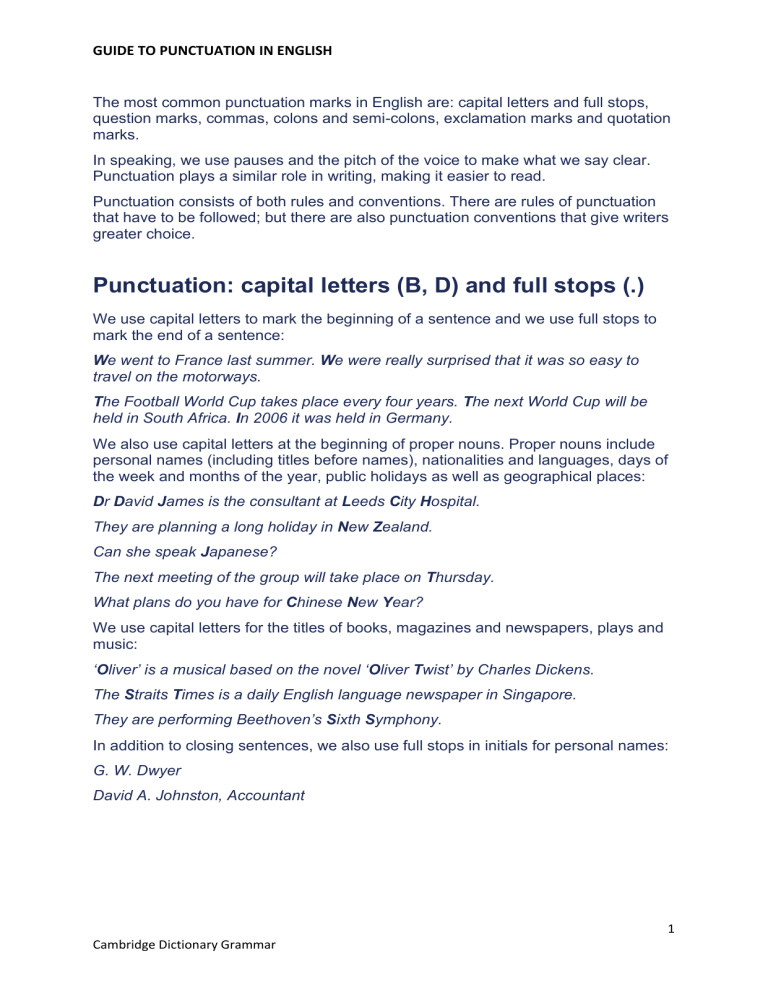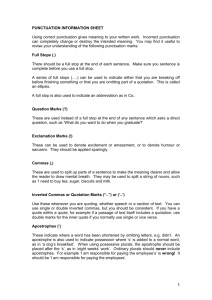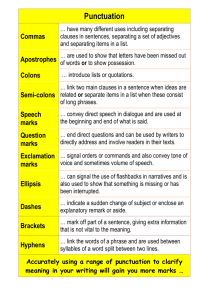
GUIDE TO PUNCTUATION IN ENGLISH
The most common punctuation marks in English are: capital letters and full stops,
question marks, commas, colons and semi-colons, exclamation marks and quotation
marks.
In speaking, we use pauses and the pitch of the voice to make what we say clear.
Punctuation plays a similar role in writing, making it easier to read.
Punctuation consists of both rules and conventions. There are rules of punctuation
that have to be followed; but there are also punctuation conventions that give writers
greater choice.
Punctuation: capital letters (B, D) and full stops (.)
We use capital letters to mark the beginning of a sentence and we use full stops to
mark the end of a sentence:
We went to France last summer. We were really surprised that it was so easy to
travel on the motorways.
The Football World Cup takes place every four years. The next World Cup will be
held in South Africa. In 2006 it was held in Germany.
We also use capital letters at the beginning of proper nouns. Proper nouns include
personal names (including titles before names), nationalities and languages, days of
the week and months of the year, public holidays as well as geographical places:
Dr David James is the consultant at Leeds City Hospital.
They are planning a long holiday in New Zealand.
Can she speak Japanese?
The next meeting of the group will take place on Thursday.
What plans do you have for Chinese New Year?
We use capital letters for the titles of books, magazines and newspapers, plays and
music:
‘Oliver’ is a musical based on the novel ‘Oliver Twist’ by Charles Dickens.
The Straits Times is a daily English language newspaper in Singapore.
They are performing Beethoven’s Sixth Symphony.
In addition to closing sentences, we also use full stops in initials for personal names:
G. W. Dwyer
David A. Johnston, Accountant
1
Cambridge Dictionary Grammar
GUIDE TO PUNCTUATION IN ENGLISH
Full stops are also used after abbreviations, although this practice is becoming less
common:
Arr. (arrival)
etc. (etcetera)
Dr. (doctor)
Prof. (professor)
See also:
•
Noun phrases
Punctuation: question marks (?) and exclamation
marks (!)
We use question marks to make clear that what is said is a question. When we use a
question mark, we do not use a full stop:
Why do they make so many mistakes?
A:
So you’re Harry’s cousin?
B:
Yes. That’s right.
We use exclamation marks to indicate an exclamative clause or expression in
informal writing. When we want to emphasise something in informal writing, we
sometimes use more than one exclamation mark:
Listen!
Oh no!!! Please don’t ask me to phone her. She’ll talk for hours!!!
See also:
•
Exclamative clauses
Punctuation: commas (,)
We use commas to separate a list of similar words or phrases:
It’s important to write in clear, simple, accurate words.
They were more friendly, more talkative, more open than last time we met them.
We do not normally use a comma before and at the end of a list of single words:
They travelled through Bulgaria, Slovakia, the Czech Republic and Poland.
American English does use a comma in lists before and:
2
Cambridge Dictionary Grammar
GUIDE TO PUNCTUATION IN ENGLISH
We took bread, cheese, and fruit with us.
We use commas to separate words or phrases that mark where the voice would
pause slightly:
I can’t tell you now. However, all will be revealed tomorrow at midday.
We had, in fact, lost all of our money.
James, our guide, will accompany you on the boat across to the island.
Separating clauses with commas
When main clauses are separated by and, or, but, we don’t normally use a comma if
the clauses have the same subject. However, we sometimes use commas if the
clauses have different subjects:
They were very friendly and invited us to their villa in Portugal. (same subject)
Footballers these days earn more money but they are fitter and play many more
matches. (same subject)
It was an expensive hotel in the centre of Stockholm, but we decided it was worth the
money. (different subjects)
When a subordinate clause comes before the main clause, we commonly use a
comma to separate the clauses. However, we do not always do this in short
sentences:
If you get lost in the city centre, please don’t hesitate to text us or phone us.
If you get lost just phone us.
When we use subordinate or non-finite comment clauses to give further details or
more information, we commonly use commas to separate the clauses:
You do need to wear a darker jacket, if I may say so.
To be honest, I thought they were very very rude.
Commas and relative clauses
We use commas to mark non-defining clauses. Such clauses normally add extra,
non-essential information about the noun or noun phrase:
The ambulance, which arrived after just five minutes, took three people to the
hospital immediately.
Hong Kong, where the first ASEAN meeting was held, is a very different city now.
The same is true for non-finite clauses:
The storm, lasting as it did for several days, caused serious damage to villages near
the coast.
3
Cambridge Dictionary Grammar
GUIDE TO PUNCTUATION IN ENGLISH
Warning:
We don’t use commas to mark defining clauses:
Barcelona was the Spanish city that was selected for the Olympic Games.
Not: … the Spanish city, that was selected …
See also:
•
Clauses
Commas and speech forms
We commonly separate tags and yes-no responses with commas:
They are going to the party, aren’t they?
No, thank you. I’ve already eaten too much.
We also usually separate vocatives, discourse markers and interjections with
commas:
Open the door for them, Kayleigh, can you. Thanks. (vocative)
Well, what do you think we should do about it? (discourse marker)
Wow, that sounds really exciting. (interjection)
We use commas to show that direct speech is following or has just occurred:
He said in his opening speech, ‘Now is the time to plan for the future.’ (or He said in
his opening speech: ‘Now is the time to plan for the future.’)
When the direct speech is first, we use a comma before the closing of the quotation
marks:
‘We don’t want to go on holiday to the same place every year,’ he said impatiently.
See also:
•
Reported speech
Punctuation: colons (:) and semi-colons (;)
We use colons to introduce lists:
There are three main reasons for the success of the government: economic, social
and political.
We also use colons to indicate a subtitle or to indicate a subdivision of a topic:
Life in Provence: A Personal View
We often use colons to introduce direct speech:
Then he said: ‘I really cannot help you in any way.’
4
Cambridge Dictionary Grammar
GUIDE TO PUNCTUATION IN ENGLISH
We commonly use a colon between sentences when the second sentence explains
or justifies the first sentence:
Try to keep your flat clean and tidy: it will sell more easily.
We use semi-colons instead of full stops to separate two main clauses. In such
cases, the clauses are related in meaning but are separated grammatically:
Spanish is spoken throughout South America; in Brazil the main language is
Portuguese.
Semi-colons are not commonly used in contemporary English. Full stops and
commas are more common.
Punctuation: quotation marks (‘…’ or “…”)
Quotation marks in English are ‘…’ or “…”. In direct speech, we enclose what is said
within a pair of single or double quotation marks, although single quotation marks are
becoming more common. Direct speech begins with a capital letter and can be
preceded by a comma or a colon:
She said, “Where can we find a nice Indian restaurant?” (or She said: ‘Where can
we find a nice Indian restaurant?’)
We can put the reporting clause in three different positions. Note the position of
commas and full stops here:
The fitness trainer said, ‘Don’t try to do too much when you begin.’ (quotation mark
after comma introducing speech and after full stop)
‘Don’t try to do too much when you begin,’ the fitness trainer said. (comma before
closing quotation mark)
‘Don’t try to do too much,’ the fitness trainer said, ‘when you begin.’ (commas
separating the reporting clause)
When we use direct speech inside direct speech, we use either single quotation
marks inside double quotation marks, or double quotation marks inside single
quotation marks:
“It was getting really cold,” he said, “and they were saying ‘When can we go back
home?’”
Jaya said, ‘They were getting really excited and were shouting “Come on!”’.
We commonly use question marks inside the quotation marks unless the question is
part of the reporting clause:
‘Why don’t they know who is responsible?’ they asked.
So did they really say ‘We will win every match for the next three weeks’?
We also use single quotation marks to draw attention to a word. We can use
quotation marks in this way when we want to question the exact meaning of the
word:
5
Cambridge Dictionary Grammar
GUIDE TO PUNCTUATION IN ENGLISH
I am very disappointed by his ‘apology’. I don’t think he meant it at all.
NEW ‘WAR’ OVER NORTH SEA FISHING PLANS
We sometimes use quotation marks to refer to the titles of books, newspapers,
magazines, films, songs, poems, videos, CDs, etc:
There’s a special report all about it in ‘The Daily Mail’.
We can use italics instead of quotation marks for these citations:
There’s a special report all about it in The Daily Mail.
Articles or chapters within books, or titles of short stories, are normally punctuated by
single quotation marks:
The longest chapter in the book is the last one called ‘The Future of Africa’.
Punctuation: dashes ( – ) and other punctuation
marks
Dashes are more common in informal writing. They can be used in similar ways to
commas or semi-colons. Both single and multiple dashes may be used:
Our teacher – who often gets cross when we’re late – wasn’t cross at all. No one
could believe it!
Just wanted to thank you for a lovely evening – we really enjoyed it.
Brackets have a similar function to dashes. They often add extra, non-essential
information:
Thriplow (pronounced ‘Triplow’) is a small village in the eastern part of England.
We use brackets around dates and page numbers in academic writing:
Heaton (1978) gives a convincing explanation of how hurricanes are formed (pages
27–32).
We often use forward slashes in internet addresses and to indicate and/or in
academic references:
You can find the figures you need on www.bbc.co.uk/finance
Binks (1995/1997) has already researched this aspect of Roman history.
Punctuation: numerals and punctuation
In British English the date is usually given in the order day, month, year.
We use full stops in dates. Forward slashes or dashes are also commonly used:
Date of birth: 1.8.1985 (or 1/8/1985 or 1–8–1985)
In American English the day and the month are in a different order so that 8 January
1985 is written as follows:
6
Cambridge Dictionary Grammar
GUIDE TO PUNCTUATION IN ENGLISH
1–8–1985 (or 1/8/1985 or 1.8.1985)
We don’t usually punctuate weights and measures and references to numbers:
4kg (4 kilograms)10m (10 metres) 5m dollars (5 million dollars)
Commas are used in numbers to indicate units of thousands and millions:
7,980 (seven thousand, nine hundred and eighty)
11,487,562 (eleven million, four hundred and eighty-seven thousand, five hundred
and sixty-two)
We use full stops, not commas, to indicate decimal points:
6.5 (six point five)
Not: 6,5
We can punctuate times with full stops or colons:
The shop opens at 9.30. (or 9:30)
Saying email and internet addresses
Spoken English:
When we speak email and web addresses, we say each word separately. To avoid
confusion, we sometimes spell out each letter of a word:
Hannah.reeves@lit.com = Hannah dot reeves at l-i-t dot com
miles_hotel.com/home = miles underscore hotel dot com forward slash home
www.theplace.org = www dot theplace (all one word) dot org
Symbols and typographic conventions
.
full stop
X.X
decimal point (2.2: two point two)
,
comma
*
asterisk
?
question mark
()
parentheses (or round brackets)
!
exclamation mark
[]
square brackets (or box brackets)
:
colon
{}
curly brackets
7
Cambridge Dictionary Grammar
GUIDE TO PUNCTUATION IN ENGLISH
;
semi-colon
°
degrees (40º: forty degrees)
“
”
double quotation marks
%
per cent
‘’
single quotation marks
&
and (also called ‘ampersand’)
’
apostrophe
©
copyright
-
hyphen
<
less than
–
dash
>
greater than
+
plus
@
at
–
minus
✓
tick
×
multiplied by (2 × 2: two multiplied
by two)
X
cross
X_X
underscore (ann_hobbs: ann
underscore hobbs)
\
back slash
÷
divided by
(6 ÷ 2: six divided by two)
=
equals
/
forward slash
8
Cambridge Dictionary Grammar



